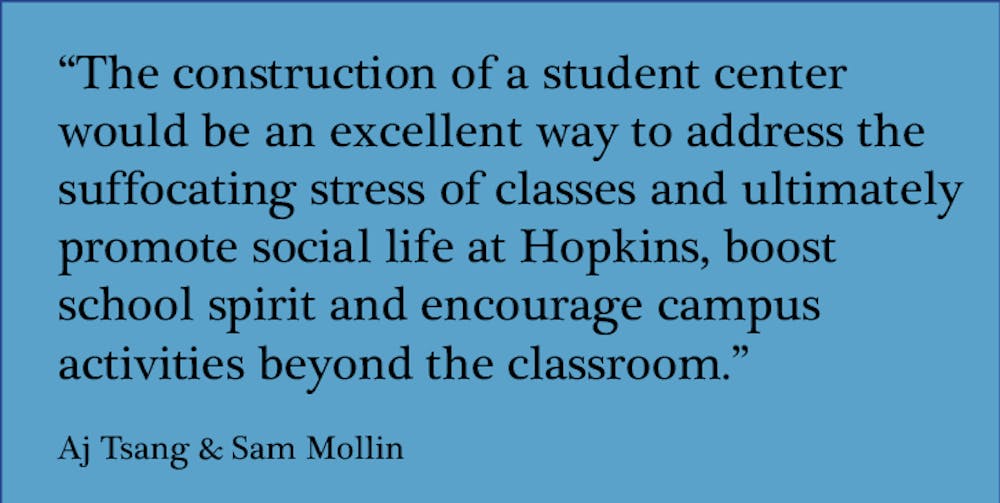For decades, Hopkins students have yearned for a student center: a central space for the collective pursuit of our social and mental wellbeing. Hopkins is an outlier. A student center exists at nearly every other college and university campus in the United States (including the 33 peer institutions to which Hopkins compares itself), but not here. More schools have a student center than an armed private police force.
What are the benefits of a student center, and how could it revolutionize the Hopkins culture?
Most importantly, a student center would allow Hopkins to centralize student services. We recognize that Hopkins provides many student services already and there are many dedicated staff who administer them. However, the core issue today is a lack of accessibility. Student services are spread so widely across campus that walking between the two farthest points where the University will offer student programming (R House and the Recreation Center) can take 25 minutes. Two of the most frequented student spaces — the Counseling Center and the Recreation Center — are themselves separated by almost a mile. With students in class most of the day, the size of our campus can seem insurmountable. When you add on the fact that campus is far from ADA-compliant, travelling between services becomes impossible.
In the long run, the distances between places like the Office for Multicultural Affairs and the Office of Sustainability can effectively nullify their impact on the community. This is an untenable status quo, especially when these services are often designed to support students in times of duress. The only way to address this issue is to build a student center containing all student services. Students should not have to walk more than 10 minutes off campus to reach support for their physical, mental and social health.
In addition, constructing a student center could reform campus culture. Some remark that Hopkins almost feels like a boarding school due to students circulating between classes, the library and their rooms with no general space to socialize in. Brody is too academic; Levering is too compact; and dining areas, like the FFC, require a meal swipe or dining dollars to enter. As such, none of these are valid alternatives to a student center in the long term. We believe that the construction of a student center would be an excellent way to address the suffocating stress of classes and ultimately promote social life at Hopkins, boost school spirit and encourage campus activities beyond the classroom.
All in all, the newfound push for a student center looks promising. In the last three years, the University has conducted the logistical, financial and architectural analyses required to build a student center. In addition, the Student Government Association (SGA) has secured the support of several key players, including the Student Experience Subcommittee of the Second Commission on Undergraduate Education (CUE2) and several deans from Homewood Student Affairs. At its annual working dinner with University President Ronald J. Daniels, SGA also secured a confirmation that a student center is high on Daniels’ priority list when talking to potential donors. Daniels said that if a “naming donor” could provide 50 percent of the funding required ($60 million), then the remainder of costs can be covered by University savings, small donations, loans and debts.
All that remains is to kickstart a public capital campaign to construct the student center. By the start of the next school year, we implore the University to make public its efforts to identify a major donor. We also ask the University to begin conversations with students and staff about current and future space needs, so we can ensure the student center is built not just for the needs of Hopkins today but for the expanding needs of Hopkins tomorrow. We further ask that, when construction begins, the union is in a central location, is ADA-accessible, remains open 24/7 and includes sufficient amenities to promote a healthier academic and social culture at Hopkins.
To our fellow students and student groups, faculty and staff: Join the effort by signing onto our student center proposal.
To the administrators of Hopkins: Make public your capital campaign for the student center.
To the parents of Hopkins: Encourage the University to build a student center, and if you can, help donate to building one.
To the donors of Hopkins: When you ask, “Where will my money be best spent?” — think of the students and donate to building a student center.
A student center is on the horizon, and begins with all of us. Let’s build one now.
AJ Tsang, SGA Executive Vice President, is a Public Health and French major from Anchorage, Alaska. Sam Mollin, SGA freshman senator, is a political science major from Mamaroneck, N.Y. Both are members of the SGA student center initiative team, which collaborated to write this piece.





